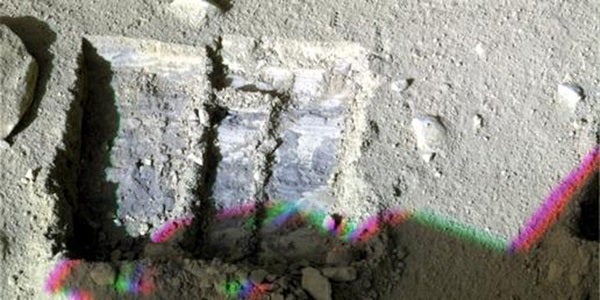The color outline of the shadow at the bottom of the image is a result of sun movement with the combined use of infrared, green, and blue filters.
As fall approaches Mars’ northern plains, NASA’s Phoenix Lander continues to dig into the red planet’s soil and deliver samples to its onboard science instruments for analysis.
During the past 2 weeks, Phoenix’s nearly 8-foot-long (2.4-meter) arm moved a rock named “Headless” about 16 inches (0.4 meter) and snapped an image of the rock with its camera. Then the robotic arm scraped the soil underneath the rock and delivered a few teaspoonfuls of soil onto the lander’s optical and atomic-force microscopes. These microscopes are part of Phoenix’s Microscopy, Electrochemistry, and Conductivity Analyzer.
Scientists are conducting a preliminary analysis of this soil sample, nicknamed “Captain Hessian.” The soil piqued their interest because it may contain a high concentration of salts, said Phoenix mission scientist Diana Blaney of NASA’s Jet Propulsion Laboratory, Pasadena, California.
As water evaporates in arctic and arid environments on Earth, it leaves behind salt that can be found under or around rocks, Blaney said. “That’s why we wanted to look under Headless, to see if there’s a higher concentration of salts there.”
Phoenix scientists also want to analyze a hard, icy layer beneath the martian soil surface. Excavating to that icy layer underneath a rock might give scientists clues about processes affecting the ice. So the robotic arm has dug into a trench called “La Mancha” to see how deep the martian ice table is.
The Phoenix team also plans to dig a trench laterally across some of the existing trenches to reveal a cross section, or profile, of the soil’s icy layer.
“We hope to learn more about how the ice depth is controlled by physical processes,” said Phoenix co-investigator Mike Mellon of the University of Colorado at Boulder. “By looking at how ice depth varies, we can pin down how it got there.”
The Phoenix Lander, originally planned for a 3-month mission on Mars, is now in its fifth month. The lander’s weather instruments have detected water-ice haze clouds in the northern martian sky, and temperatures are getting colder as the daylight hours wane.
Phoenix faces an increasing drop in solar energy as the Sun dips longer below the martian horizon. Mission engineers and scientists expect this power decline to curtail activities in the coming weeks. As darkness deepens, Phoenix will become primarily a weather station. The lander will likely cease all activity by the end of the year.










